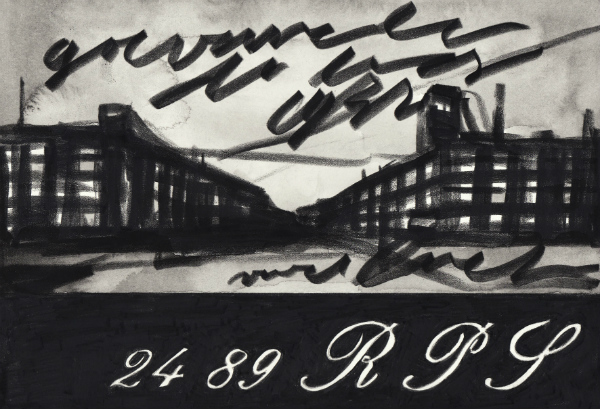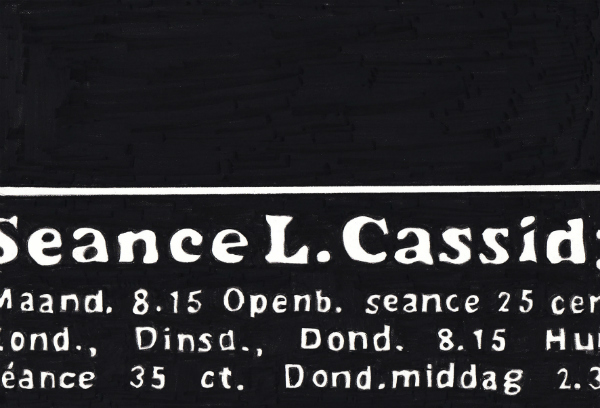Art & Exhibitions
artnet Asks: Master of Noir Marcel van Eeden
Find out why the Dutch artist is not afraid of death.

Photo: Stefan Rohner, Via: yiaos.com
Find out why the Dutch artist is not afraid of death.

Hili Perlson

The Dutch artist Marcel van Eeden is fascinated with what the world looked like before 1965, the year he was born. His predominantly monochrome drawings take photographs pre dating this year as a point of departure to create scenes reminiscent of noir graphic novels, filled with haunting nostalgia.
During Berlin Gallery Weekend, van Eeden will launch “The Symmetry Argument,” a two-part exhibition at Sprüth Magers and Kromus + Zink. In the large-scale drawings spread across the two spaces, van Eeden looks to a specific period in Europe, between the 1920s and 40s, when a wave of spiritualism swept over his hometown of The Hague.
artnet News spoke to van Eeden about occultism, communicating with the past over radio waves, and why we shouldn’t fear death.
What is the difference between the two parts of the show?
Both shows have the same title: “The Symmetry Argument,” which I found in the writings of Lucretius. I wasn’t familiar with this before, but in the poem “The Nature of Things” Lucretius makes the Epicurean argument that your situation in the period before you were born is the same as it will be after you die. You don’t have any memories of this period, so therefore, you shouldn’t be afraid to die. Death is merely a return to the eternity that existed before your birth. The two parts reflect this symmetry.
Why did this maxim strike a chord with you?
I find it to be very connected to my world. I came across it only a year ago, but what I’ve been doing for 30 years echoes precisely this philosophy. For three decades now, I’ve been working with images from the time before I was born, because I like this idea of seeing what the world was like before my conception. I find that very intriguing. It’s strange, though—so much has been written about my work over the years, and no one ever brought up this connection. Some writers mentioned Schopenhauer, Nietzsche, or even older Hindu concepts, but never Lucretius.

Marcel van Eeden Untitled, 2015
Photo: © Marcel van Eeden Courtesy Sprüth Magers
There’s a strong narrative element in your previous work, reminiscent of graphic novels. The new drawings, however, seem more intuitive. What has changed for you?
In previous works, I would construct stories with found images and texts which I put together into fiction. I was culling from historical facts but the narrative was still fictitious. I always say it’s like a box of Lego: I take building blocks from history and put them together into a new narrative. I was intrigued that it actually worked, that it was possible to write stories this way. The new show leaves narration aside, and I go back to where I started as an artist: to the pictures of The Hague.
What happened in The Hague before you were born?
During the 1920s and 40s, there were a lot of occultists and spiritualists working in the city. It was widespread in the years of instability between the World Wars, but it was especially popular in The Hague, because retired Dutch bureaucrats returned from the colonies—Indonesia in particular—and brought with them an interest in exotic spiritual traditions, including ‘guna-guna’, or black magic.

Marcel van Eeden Untitled, 2015
Photo: © Marcel van Eeden Courtesy Sprüth Magers
Some of the drawings depict streets and others, newspaper ads. Are those advertisements for spiritualist services?
Yes, many occultists were holding séances and offering sessions. I researched the addresses in the ads and realized they were all over the city. Then, in pictures of The Hague from that time, I noticed that all the houses had antennas on them. So I had this thought that I am now trying to reach back into the past, to the moment when these pictures were taken, and communicate with the people doing a séance over the radio waves. Maybe I’m the ghost.
The “Symmetry Argument” is a two-part exhibition, on view at Sprüth Magers and Kromus + Zink, Berlin, from May 2-July 18.